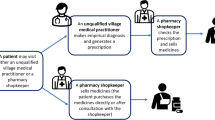Abstract
Background In Malaysia, antibacterial agents are among the most utilized drugs. There has been an increase in their use in recent years, contributing to an increase of antimicrobial resistance (AMR). Objectives This study explores the pattern of antibiotic use and practices in a Malaysian community and identifies the variables associated with a likelihood of non-compliance with a course of antibiotic treatment. Setting The study was conducted in Cheras, a community located to the south-east of Kuala Lumpur, the capital city of Malaysia. Method A cross-sectional survey was conducted with 250 individuals, using an interviewer-administered questionnaire in Cheras, Kuala Lumpur, Malaysia. Main outcome measures Frequency of antibiotic use, sources of antibiotics, use of antibiotics without prescription, discontinuation of antibiotic treatment, antibiotic resistance awareness, handling of unused antibiotics, and association between respondents characteristics and compliance with a course of antibiotic treatment. Results Approximately 36 % of the participants (n = 91) had taken antibiotics in the year of the study. The majority (66.8 %) obtained antibiotics from clinics. Almost 80 % of the participants had never obtained antibiotics without a doctor’s prescription. Nearly 55 % discontinued the course of antibiotics once symptoms disappeared. The most common method of disposing leftover antibiotics was throwing them into the household rubbish bin (78.8 %). Only 6.4 % of participants returned leftover antibiotics to the pharmacist or doctor. Univariate analysis revealed that male gender (p = 0.04), lack of knowledge of antibiotic functions (p < 0.0001), and lack of awareness of antibiotic resistance (p < 0.0001) were all significantly associated with a greater likelihood of non-compliance with a full course of prescribed antibiotic treatment. Conclusion Most individuals in the Malaysian community obtained antibiotics through prescription. Non-completion of a course of antibiotic treatment and improper disposal of unused antibiotics need to be addressed to prevent AMR. Male gender, lack of knowledge and awareness of antibiotics and resistance were significantly associated with a greater likelihood of non-compliance with a full course of prescribed antibiotic treatment. Therefore, patient education and counselling about antibiotics and antibacterial resistance is very important to enhance compliance to antibiotic therapy.
Similar content being viewed by others
References
Kardas P, Devine S, Golembesky A, Roberts C. A systematic review and meta-analysis of misuse of antibiotic therapies in the community. Int J Antimicrob Agents. 2005;26:106–13.
Pharmaceutical Services Division and Clinical Research Centre, Ministry of Health Malaysia. Malaysian statistics on medicine 2008. Kuala Lumpur: Ministry of Health Malaysia; 2013. (ISSN: 1823-8300).
World Health Organization. Antimicrobial resistance [Internet]. 2013 (updated 2013 May; cited 2014 Jan 1). Available from: http://www.who.int/mediacentre/factsheets/fs194/en/.
Ahmad N. Summary of National Surveillance of Antibiotic Resistance Report 2011 (Internet). 2011 (cited 2014 Jan 4). Available from: http://www.imr.gov.my/images/uploads/Summary%20of%20antibiotic%20resistance%202011.pdf.
Rosenblatt-Farrell N. The landscape of antibiotic resistance. Environ Health Perspect. 2009;117:A244–50.
National Collaborating Centre for Infectious Diseases. Community-acquired antimicrobial resistance: consultation notes (Internet). 2010 (updated 2010 Feb 11; cited 2014 Jan 15). Available from: http://www.nccid.ca/files/caAMR_ConsultationNotes_final.pdf.
Grosso G, Marventano S, Ferranti R, Mistretta A. Pattern of antibiotic use in the community: non-adherence and self-prescription rates in an Italian urban population. Mol Med Rep. 2012;5:1305–10.
Department of Statistics, Malaysia. Population distribution by local authority areas and mukims, 2010 [Internet]. 2011[cited 2014 Jan 15]. Available from: http://www.statistics.gov.my/portal/download_Population/files/population/05Jadual_Mukim_negeri/Mukim_WPKL.pdf.
Oh AL, Hassali MA, Al-Haddad MS, Sulaiman SA, Shafie AA, Awaisu A. Public knowledge and attitudes towards antibiotic usage: a cross-sectional study among the general public in the state of Penang, Malaysia. J Infect Dev Ctries. 2011;5:338–47.
Lim KK, Teh CC. A cross sectional study of public knowledge and attitude towards antibiotics in Putrajaya, Malaysia. South Med Rev. 2012;5:26–33.
Shehadeh M, Suaifan G, Darwish RM, Wazaify M, Zaru L, Alja’fari S. Knowledge, attitudes and behavior regarding antibiotics use and misuse among adults in the community of Jordan. A pilot study. Saudi Pharm J. 2012;20:125–33.
Tong AY, Peake BM, Braund R. Disposal practices for unused medications around the world. Environ Int. 2011;37:292–8.
Balbay O, Annakkaya AN, Arbak P, Bilgin C, Erbas M. Which patients are able to adhere to tuberculosis treatment? A study in a rural area in the northwest part of Turkey. Jpn J Infect Dis. 2005;58:152–8.
Jin J, Sklar GE, Oh VM, Li SC. Factors affecting therapeutic compliance: a review from the patient’s perspective. Ther Clin Risk Manag. 2008;4:269–86.
Kardas P. Patient compliance with antibiotic treatment for respiratory tract infections. J Antimicrob Chemother. 2002;49:897–903.
Pechère JC, Hughes D, Kardas P, Cornaglia G. Non-compliance with antibiotic therapy for acute community infections: a global survey. Int J Antimicrob Agents. 2007;29:245–53.
Chuah SY. Factors associated with poor patient compliance with antituberculosis therapy in Northwest Perak, Malaysia. Tubercle. 1991;72:261–4.
Babwah F, Baksh S, Blake L, Cupid-Thuesday J, Hosein I, Anneela S, et al. The role of gender in compliance and attendance at an outpatient clinic for type 2 diabetes mellitus in Trinidad. Rev Panam Salud Publica. 2006;19:79–84.
Kim SS, Moon S, Kim EJ. Public knowledge and attitudes regarding antibiotic use in South Korea. J Korean Acad Nurs. 2011;41:742–9.
Acknowledgments
The author acknowledges Chang Lina, Foo Kah Keet, Low Chia Wen, Sabita Mani, Chiu Li Peng for their assistance in the data collection for this study.
Funding
This study received no specific grant from any funding agency in the public, commercial, or not-for-profit sectors.
Conflicts of interest
There are no conflicts of interest to disclose.
Author information
Authors and Affiliations
Corresponding author
Rights and permissions
About this article
Cite this article
Fatokun, O. Exploring antibiotic use and practices in a Malaysian community. Int J Clin Pharm 36, 564–569 (2014). https://doi.org/10.1007/s11096-014-9937-6
Received:
Accepted:
Published:
Issue Date:
DOI: https://doi.org/10.1007/s11096-014-9937-6



